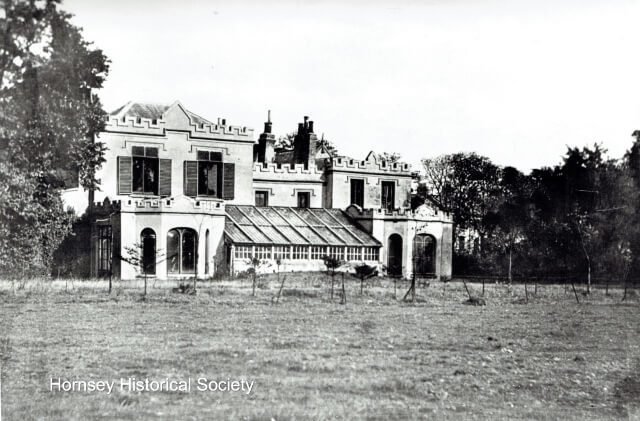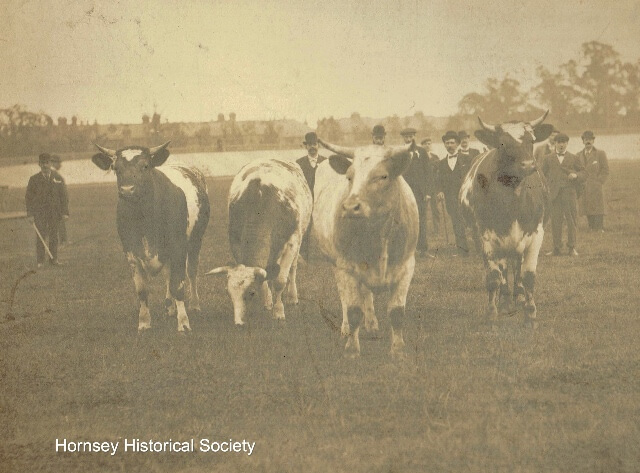This is the sixth in our series on Lost Houses of our area. This edited text was written by the late Albert Pinching, HHS Sales Manager for 21 years and editor for 14 years of our annual journal, the Bulletin, who died at the end of July this year. The full text was a chapter in People and Places: Lost Estates in Highgate, Hornsey and Wood Green’, published by HHS in 1996.

Before the advent in 1859 of Wood Green Station (now Alexandra Palace Station) on the Great Northern Railway (GNR) much of the area was farmland claimed from the Great Forest of Middlesex. One of the few distinctive buildings was Nightingale Hall, situated on the SW side of Bounds Green Road. It covered the site now occupied by the Adventist Church, with its outbuildings and gardens extending over what are now Northcott and Cornwall Avenues.
Early origins of the estate
The Nightingale Hall estate was situated on land cleared in medieval times from the eastern flank of Tottenham Wood. It was manorial land called Woodriddings or Woodreddings meaning ‘clearance in the wood’. Tottenham Court Roll records of ownership and tenancy trace it from the time of Richard II (1377-1400). The earliest reference is 1392 when the land was held by John Northampton, a Lord Mayor of London.
There were several owners during the 16th century, all prosperous London citizens. The Dorset Survey of 1619 (the ‘upside down map’, copies of which are on sale in the Old Schoolhouse – editor) indicates that the land was leased to a Robert Morris but provides no information about a building. During the 17th and 18th centuries the copyright tenancy was held by several prominent London citizens who were also substantial landowners elsewhere. None of them appear to have lived on the estate which was mainly pasture, leased probably for grazing.
In 1769 John Giles, a ‘Gentleman’ and Tottenham resident, was admitted as Copyright Tenant of all that is
‘commonly called or known by the name of Woodridding otherwise Wood Green Farm situate in Bounds Green Lane … together with the yard, garden, orchard, barns, stables, outhouses and buildings … and also all those eight several Meadow or pasture fields to the said farm now in the tenure of Matthew Twydall (at a yearly rent of eighty pounds) … bounded to the West by Tottenham Wood …’
Nightingale Hall Estate emerges
By the early 19th century it is possible to relate the boundaries of the estate (direction in brackets), by now called Nightingale Hall, to present day features in Wood Green, such as Albert Road Recreation Ground (N), Alexandra Palace and Park (NW), a line along Clifton Road, Victoria Road, Palace Gates Road and Bridge Road (SW) and Bounds Green Road (E).
Occupancy of Nightingale Hall during the 19th century
When John Giles died in 1807 the estate was divided between his heirs and then passed into the Woodward family. In 1820 reference is made to Thomas Rhodes who seems to have occupied the Hall, farm and pastures for some time during 1825-1840. Thomas Rhodes was a dairy farmer and owner of the adjacent Tottenham Wood Farm.
Mary Ann Woodward, an absentee landlord, found tenants for Nightingale Hall and farm and extended the estate by 10 acres to the south. These acquisitions brought into the estate two very old entities, ‘Dears Pightell’ (now St Michael’s Terrace, Dorset and Terrick Roads) and ‘Bakersfield’ (now part of Nightingale Gardens between Park and Braemar Avenues). These had been the subject of a grant by Henry VIII to Henry Audeley and John Cordall in 1544 and they were mentioned in the 1619 Dorset Survey.
The coming of the railways
The Great Northern Railway Act of 1846, which facilitated the construction of a railway from King’s Cross to the North, was to have a major impact on the fortunes of the Nightingale Hall Estate. GNR bought over five acres for £2,660 in 1848, effectively dividing the entity known as Woodriddings for almost 500 years into two almost equal parts. Two years later Thomas Rhodes purchased the land west of the GNR line for £1,900. The rest of the estate, including Nightingale Hall, was sold to Thomas Pearson for £1,800. He became the first copyhold tenant to actually reside at Nightingale Hall.
The 1850 papers recording the admission of Thomas Pearson as Copyhold Tenant describe Nightingale Hall as having on the Ground Floor: Dining, Drawing and Breakfast Rooms, a Conservatory and Billiard Room, the Kitchen, Scullery and Offices, a Basement and Cellars. On the First Floor: 5 Bedrooms and one Dressing Room and on the Second Floor: 2 Bedrooms and a large Organ Room. An additional residence is mentioned, possibly a farmhouse, comprising 4 bedrooms and dressing room, 3 sitting rooms, 2 kitchens and a dairy. A description in 1864 includes stables with coach and cart horses, cow houses and piggeries.
Further loss of land adjacent to Nightingale Hall followed in 1853 when 2 acres was sold for £2,6000 to the New River Company because of the culverting of the New River along its eastern flank through what is now Nightingale Gardens. After Thomas Rhodes’ death in 1856, aged 93, a large part of his farmland was sold by his family and replaced by Alexandra Park (1862). He was great uncle of the much-debated imperialist Cecil Rhodes.
Nightingale Hall in the hands of Mrs Pearson-Kidd
Thomas Pearson died in 1862 and Mrs Pearson became the owner in 1864. By 1881 she had re-married and become Mrs Pearson-Kidd, her new husband being John Kidd, a printing ink manufacturer. Other residents at the time of the 1881 Census were Mrs Pearson’s aging aunt, three other relatives, four domestic servants and a nurse. Mrs Pearson, who owned several other properties in Wood Green, was a substantial benefactor, for example of St Michael’s Church, Wood Green, and St Michael’s Senior Schools (now rebuilt as St Michael’s CE Primary School).
Mrs Pearson-Kidd died in December 1890 and Nightingale Hall, by then a freehold property, and her other freehold properties were put up for sale by auction. By the time of her death further erosion of the estate had occurred (1877) with the building of the Enfield branch of the GNR. The sale plan of 1891 shows Nightingale Hall and its immediate surroundings comprising only 10 acres. A contemporary account of 1891 describes:
‘the staircase had some fine large paintings on its walls and being so wide that you can go up six abreast. The music room was fine with a large organ which I believe was sold to the Wesleyan Chapel in Trinity Road.’
